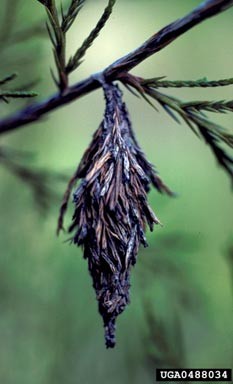Bagworms
Introduction
Bagworms are a very common and potentially serious pest of evergreen ornamentals in North Carolina. Heavy infestations on preferred hosts such as juniper and arborvitae can result in complete defoliation, branch dieback, or tree mortality. Bagworms, named for the bag-like sac formed around feeding larvae, are actually the larval stage of a small moth. However, female bagworms never become a moth in the typical sense: they are wingless, legless, lack antennae and mouthparts, and spend their entire lives inside of their larval bag.
Identification
Larvae construct an elongated silk bag interwoven with twigs and foliage within which they feed and pupate. The bag is enlarged as the larvae grows, and may eventually become 2 1⁄2 inches long. Larvae feed only on the epidermal cells of foliage; therefore the foliage remains on the tree, but will turn brown and die. Heavily infested branches or trees may turn completely brown, may have a fire-scorched appearance, and will be covered in hundreds of bags hanging from twigs by mid-summer. Females never leave their bag; adult males are small black moths with clear wings and a one inch wingspan.
Management
Practical control can be achieved on small to medium size trees by picking off the larvae during the growing season, or by removing the bags of females harboring eggs during the winter. Removed bags should be destroyed. Insecticides are available and effective against actively feeding larvae.

